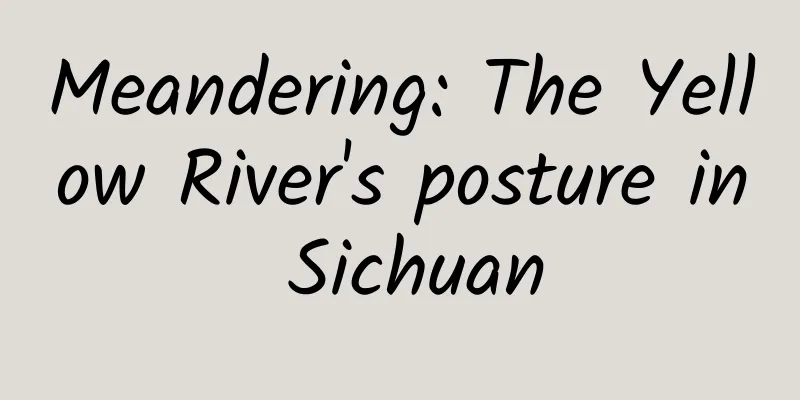Meandering: The Yellow River's posture in Sichuan

|
A meander, also known as a river bend or a snake-like river, refers to a river section where the river channel is curved like a snake. Meanders are divided into free meanders and deep meanders, which are the most elegant and gentle sections of the river. This type of river is mainly controlled by topographic conditions. Free meanders often appear in open areas, while deep meanders are often formed on the basis of free meanders due to the uplift of the earth's crust and the rapid cutting of the river. ▲Natural meander. Photo by Wang Zhi 01Meander: The most beautiful river The meanders are varied and beautiful in form, but the principle of their formation is very simple. When a river flows through a flat and open area, the riverbed slope decreases, the downward erosion effect weakens, and the erosion effect on the banks on both sides increases. The river continues to erode the riverbank, causing the river channel to bend. Therefore, lateral erosion is the key to the formation of meanders. The concave part of a curved river bank is called a concave bank, and the convex part is called a convex bank. When the river reaches the bend, due to inertia and centrifugal force, the water flows continuously toward the concave bank, which keeps retreating and getting deeper and deeper. ▲The formation of meanders At the same time, a compensating water flow toward the convex bank is generated at the bottom of the river, which presses the bottom water flow toward the convex bank and transports the silt washed down from the concave bank to the convex bank, forming a beach. As the meander continues to develop, the two adjacent concave banks get closer and closer, and eventually they are directly connected. This is the common straightening of meanders. The remaining river channel after being cut off forms an oxbow lake. These two oppositely directed currents form a transverse circulation in the cross section of the river. Under the action of the transverse circulation, the river channel becomes more and more tortuous, and eventually forms a meander. The new river section after the bend is straightened will form a new meander under the action of inertia and centrifugal force, and then straighten the bend, thus repeating the process, and eventually leaving traces of the drift and swing of the new and old river channels and a large number of river trace lakes on the earth. ▲ Animation of meander formation. Source: Judengkan The formation of meanders requires two natural conditions. First of all, the terrain must be relatively flat, and there must be a moderate drop. If the drop is too large, the river's downward cutting speed will be faster than the lateral erosion, and a canyon will be formed instead of a meander. If the drop is too small, the river will accumulate and form a lake, and it will not be able to flow in the riverbed, and lose its erosion ability. Secondly, the surface of the river should be just right in hardness and looseness. If the surface is too hard, the river water cannot cut down, and only beach flow and turbulence will form. If the surface is too soft or too loose, the beautiful meandering shape will not be easily preserved. The source of rivers in Sichuan, or the grassland areas with flat terrain such as mountain basins, are the most likely places for meanders to form. The surface plants with well-developed root systems on the grassland can "preserve" the shape of free meanders very well, making it difficult for the river bank to collapse under the scouring of running water. ▲The formation of meanders 02Meandering: The Yellow River in Sichuan The Yellow River flows through Shiqu, Aba, Hongyuan, Ruoergai, Songpan and other places in the northwest corner of Sichuan, all of which are high-altitude areas with relatively flat terrain. The river meanders along the way, winding all the way to the sky, forming the most beautiful "Yellow River Curve". ▲The Baihe meander peak in the upper reaches of the Yellow River. Photo by Wang Zhi Zoige Grassland is a very special area on the eastern edge of the Qinghai-Tibet Plateau, where the Yellow River flows. Its altitude is between 3,300 and 3,600 meters, and it is also known as the Songpan Plateau. Although Ruoergai is a plateau, compared with the Min Mountains to the east, the Qionglai Mountains to the south, the Goluo Mountains, the Amnye Machen Mountains, the Xiqing Mountains to the west and the Western Qinling Mountains to the north, it is a plateau basin surrounded by mountains. The main stream of the Yellow River enters the Ruoergai Basin from the canyon section, meanders in the most beautiful curve in this vast flat grassland, enters the canyon again in Maqu County, Gansu Province, and then rushes eastward to the Loess Plateau. The river water is chaotic and the waves are surging, which is a completely different appearance. The clearest and most gentle shadow of the Yellow River is in this section of Ruoergai. ▲The first bend of the Yellow River. Photo by Tuchong Creative Heihe River and Baihe River are the main tributaries of the Yellow River in the Zoige Basin. They both originate in the eastern part of the Zoige Basin. Because they flow through the Zoige Basin, they have the terrain conditions for the development of free river meanders, and the river channels are therefore highly winding. The Heihe River is also known as the Moqu River, Maiqu River, Dongyaqia River and Ruoergai River. Because it flows through the peat layer of the swamp meadow, the black peat on both sides is exposed by the erosion of the water, and the water color is also dyed gray-black, hence the name "Heihe River". The Heihe River originates from Dongyaqia in Zhebo Mountain at the western foot of Min Mountain, flows northwest through the Ruoergai Prairie, and merges into the Yellow River in the east of Maqu. The Heihe River basin has gentle hills and wide valleys, well-developed meanders, and many oxbow lakes. The total length is 445 kilometers, with a total of 237 oxbow lakes, an average of one every 2 kilometers. The lower reaches of the Heihe River are mostly lakes and swamps, with rich peat reserves and abundant aquatic plants. The Hequ horse, one of the three famous horses in my country, is produced here. ▲Heihe meander, Photo by Yang Jian Baihe River, also known as Gaqu and Anqu, originates from Chaleken at the eastern end of Bayankala Mountain, flows from south to north through Hongyuan County, and merges into the Yellow River west of Sok Temple in Tangke Town. After entering the Hongyuan Prairie, the Baihe River slows down and its river channel bends more sharply, leaving behind a series of oxbow lakes and abandoned river channels. According to statistics, the Baihe River is more than 120 kilometers long from the Longriba Gorge to the Tangke River, winding through more than 150 semi-enclosed circles, more than 10 perfect Ω-shaped river bays, and forming 82 oxbow lakes. ▲The meander of Baihe River. Photo by Wang Zhi Among them, Moon Bay on the west side of Hongyuan County is the best place to watch the meander of Baihe River, and Moon Bay is a classic among the thousands of beautiful river bays of Baihe River. The Baihe River winds here, forming a crescent-shaped river bend. Not only is the river bend beautiful, but the distant mountains are undulating, and the grasslands are spread over thousands of miles with flowers. In the early morning and evening, the sun shines on the river bend, and the river and lake water are golden and sparkling, with infinite beauty gathered in the clouds. ▲The Moon Bay formed by the Baihe River. Photo by Li Zhongdong Since ancient times, the Yellow River has been known to have "nine bends and eighteen turns", and the "First Bend" is located in Tangke Town, Ruoergai County, where the Baihe River and the Yellow River meet. The Yellow River flows slowly from the west, while the Bai River meanders in from the south. The two rivers embrace and merge into one in front of the Sok Zang Monastery like two long snakes. Then the Yellow River turns 180 degrees and meanders northwest across the prairie, leaving the S-shaped first bend of the Yellow River here. ▲The First Bend of the Yellow River, Photo by Wang Zhi In addition to the Heihe River and the Baihe River, there is a short tributary on the right bank of the Yellow River called Jiaqu. It originates from the mountains at the junction of Aba County and Hongyuan County, meanders northward, and is only 136 kilometers long. It flows through grassland and swamp areas, leaving the most complex diversion meander relics and the most densely populated river traces and lakes at Manzatang, and then flows northward into the Yellow River. Satellite images show that the wide river valley is full of new and old meanders, which are intertwined and tangled. Some people compare meanders to waltz steps, because waltz steps are to slide forward with rotations in opposite directions. Here, the Yellow River and its tributaries are like pairs of dancing partners. They use the Ruoergai grassland as their dance floor and continuously dance northward in a pirouette, leaving behind their moving figures and graceful curves. This forms an incomparably magnificent geological wonder that is breathtaking. ▲Manzatang, Photographed by Qiushi (PhotoChong Creative) The flow of the Yellow River in Ruoergai is completely unexpected, and it overturns our impression of the violent water of the Yellow River. The Yellow River before us is entwined with the Baihe River and the Heihe River, winding and meandering across the vast grassland, with ripples on the water. They seem to cherish every moment here, taking three steps and looking back twice, like affectionate lovers. ▲The meander of the Black River, photo by David Huang (Photo by Tuchong Creative) -END- By Li Zhongdong Editor | Lao Xia Image | Wang Zhi, Yang Jian, Li Zhongdong, etc. Source: "Xia Ke Geography" public account |
<<: The only cancer in the world that can be prevented by a vaccine! Should men get vaccinated?
>>: Revealed! Why do some people's ashes appear colorful after cremation?
Recommend
One year after the landing of Tianwen! Did Zhurong discover water on Mars? It has something to do with manned Mars exploration
On May 15, 2021, the Tianwen-1 probe successfully...
Drinking vinegar can soften blood vessels? What you really need to do is this...
gossip "Drinking vinegar can soften blood ve...
From a Boxer Indemnity student to the president of the Chinese Academy of Sciences, why did he first propose to develop the country through science and technology?
August 17, 1937 was the fifth day of the Battle o...
Beware! There are as many as 6,000 parasites! Don't touch this thing if you see it
These past few days A Shenzhen resident discovere...
You can also make 500,000 yuan a month by relying on information flow!
Before we start today's topic, let's look...
Can Pechoin’s 0.008% conversion rate wake you up from your dream of swiping the screen?
Recently, Pechoin ’s amazing advertisement was al...
Basic knowledge! Grid design principles and techniques that UI designers need to master
Editor's note: This article is suitable for n...
Bidding promotion: a universal method to improve bidding conversion rate!
There are many bidding issues, but in my opinion,...
Poor traffic conversion recently? Share 8 high conversion techniques!
If you were asked to choose between the following...
No need to wait for express delivery. Alipay launches "Send Now Pay Later" service
In the past 10 months of 2021, the country's ...
"Big cat"? "Freeloader"? Let's take a look at the ancient history of the "king of the grassland"
There is an animal that is both familiar and unfa...
Tesla is caught in the "reduction in configuration" scandal: speed is the key to success and speed is also the key to failure!
Perhaps it is due to the founder's personalit...
Hippocampus portrait intensive course 6 lessons portrait intensive course
Hippocampus Portrait Refining Course 6-hour Portr...
China becomes Cadillac's largest single market for the first time
With Cadillac's rapid growth in China over th...









